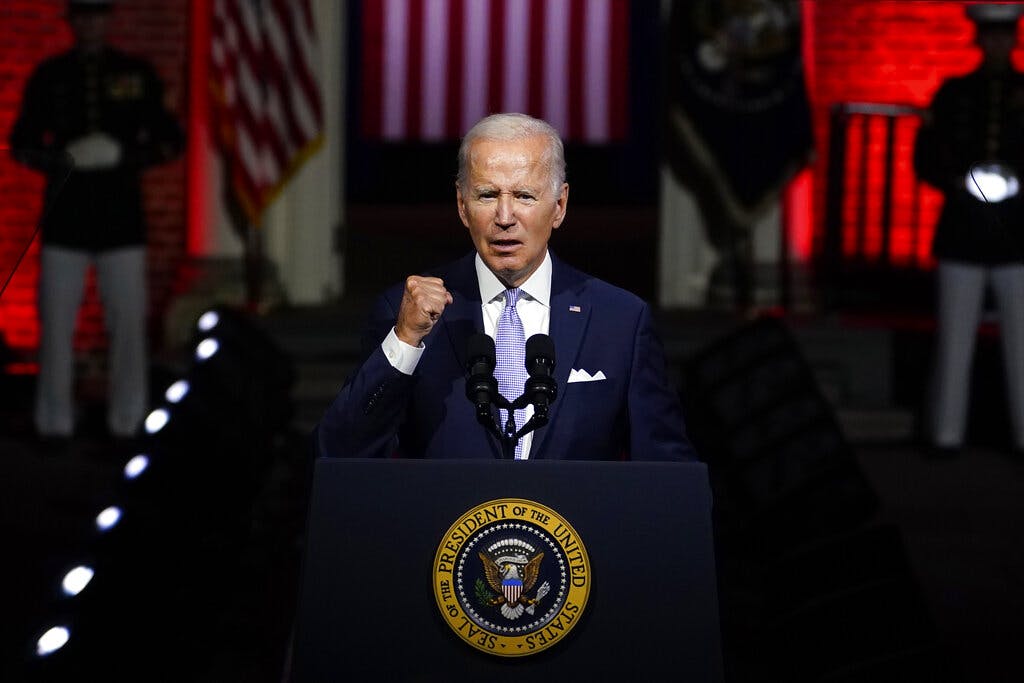In War on Terror 2.0, the Watchword Is: ‘Be Careful for What You Wish’
The narrative coming from the administration decries the threat of violence from only the right.

“This is not acceptable,” said the wife of an arrested anti-abortion protester, bewildered at the show of force of heavily-armed FBI agents raiding their house. Together with other unarmed activists, her husband had temporarily blocked the entrance to an abortion clinic in Tennessee. Most of these protesters face charges that could lead to 11 years in prison.
Meanwhile, thus far, no arrests or charges have been made connected to the string of attacks, arsons and firebombings of churches and pregnancy clinics perpetrated by the far-left extremist group Jane’s Revenge. A tracker of pro-abortion attacks in America, last updated on September 22, identified almost 100 attacks on pro-life organizations and entities.
The narrative coming from American officials, academics, and the press almost uniformly decries the threat of right-wing violence, and argues that January 6 justifies a new War on Terror, this time against homegrown extremists. The assumption is that the Americans extremists of today are like the foreign terrorists of the past.
The current threats are “very similar to insurgency movements that we’ve seen overseas,” warned the former CIA director, John Brennan. January 6 and September 11 are not just comparable, said Vice President Harris, they “echo throughout history in our collective memory.”
Despite the handwringing from the left, are any of these claims evidence-based? In an new study, Jacob Zenn of Georgetown University’s Security Studies Program shows that the threat of right-wing violence has been inflated to provide justification for War on Terror 2.0. His findings are in line with a recent FBI whistleblower assertion that “the demand for White supremacy vastly outstrips the supply of White supremacy.”
Mr. Zenn suggests that “far-right” is being used as a catch-all term to categorize as many incidents as possible as “terror,” while the same criteria (ideological allegiance or social media posts, for example) are not being used to categorize incidents spurred by “far-left” activists, as several examples show.
For example, the FBI ruled the 2017 attack on the House GOP Whip, Representative Steve Scalise, and other Republicans a “suicide by cop,” notwithstanding the shooter’s track record of hate speech toward Republicans and the fact that he had a hit list in his pocket of GOP lawmakers.
Similarly, when Matthew Dolloff shot and killed a right-wing Navy veteran in 2020 while providing security for a “BLM-Antifa” counter-protest in Denver, the murder was not labeled “far-left terrorism,” despite his history of far-left activism. Alarmism about the threat posed by the far-right has been accompanied by an increasing use of incendiary rhetoric from top politicians against domestic “enemies.”
For Congressman Hakeem Jeffries, Democrat of New York, President Trump is an “existential threat” to the United States. Senator Schumer has said that Supreme Court justices would “pay the price” for overturning Roe v. Wade. President Biden repeatedly singles out “MAGA Republicans,” likening them to “semi-fascists.”
In a speech titled “The Continued Battle for the Soul of the Nation,” Mr. Biden stated that MAGA republicans are committed to “destroying American democracy,” Democrat Maxwell Frost, running for a House seat in Florida, agrees. Republicans, she says, are trying to build a “right-wing fascist power.”
Overnight, Democrats forgot the alarm they sounded for four years under Mr. Trump: incendiary rhetoric from political leaders makes political violence more likely. They were right. Today’s incendiary rhetoric can lead to politically-motivated attacks against people or entities perceived as “right-wing” threats.
It already has. We saw this in the attempted murder of Justice Brett Kavanaugh. In Michigan a man was charged after shooting an 84 year old anti-abortion canvasser, telling a 911 dispatcher, “she’s a right-wing nut.”
Around the same time, in North Dakota, a teenager was run over and killed by a man driving a pick-up truck after a political altercation at a bar. The accused told a 911 dispatcher that the victim was in a “Republican extremist group.”
A “War on Terror 2.0” will only increase the perception of state violence against political enemies, creating conditions for further violence. It should not be forgotten that the militia movement in the 1990s grew rapidly after the incident at Ruby Ridge, where a deadly standoff with the FBI powered an anti government and paramilitary movement.
“Be careful what you wish for,” goes the old saying. Any expansion of counterterrorism tactics — with a further imbalance between national security and civil liberties — will likely become a permanent tool for any future administration. The supporters of such tactics against today’s “insurgents” may find themselves the target tomorrow.

